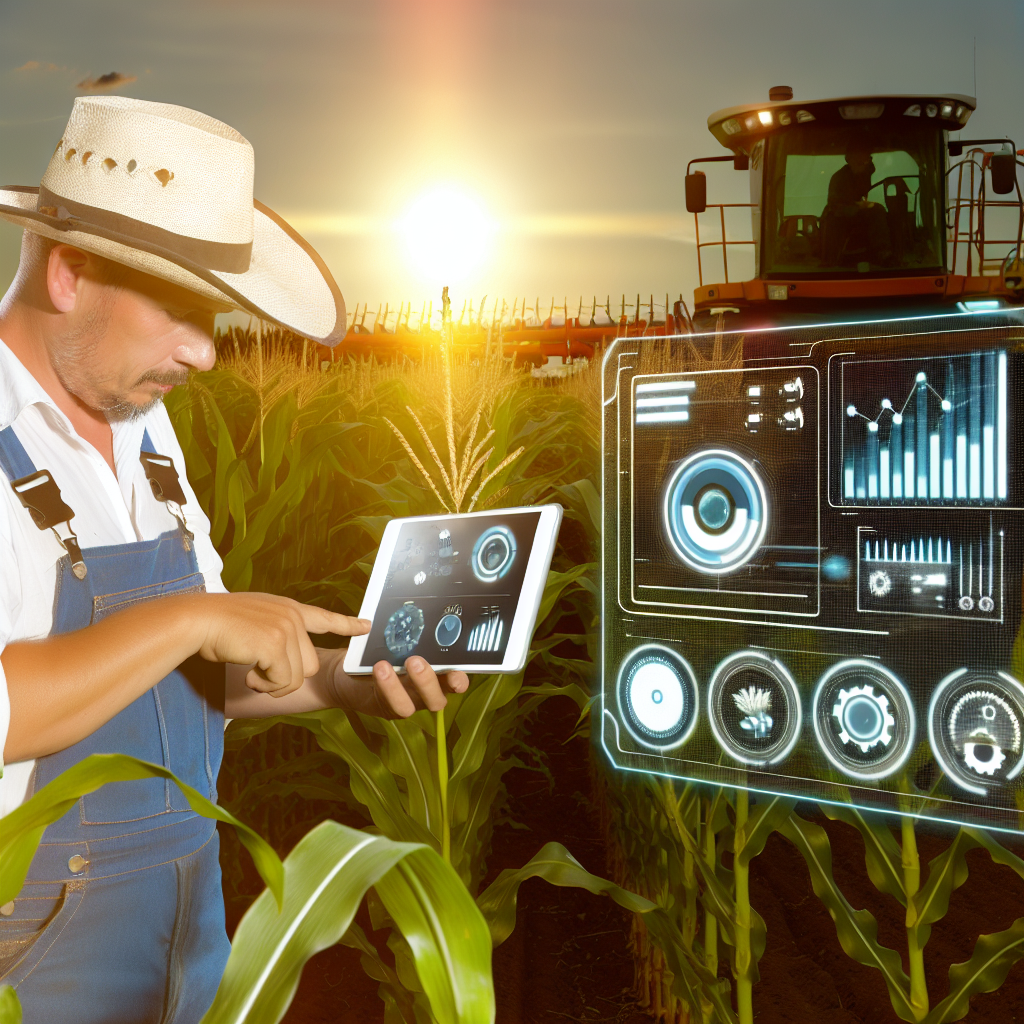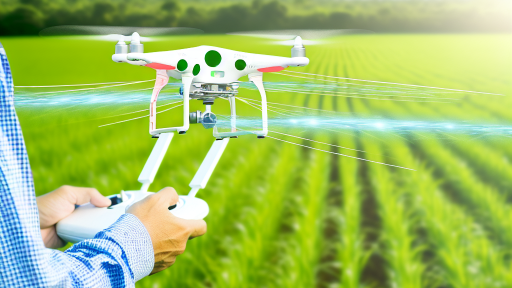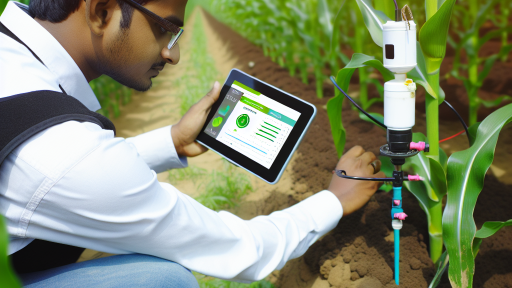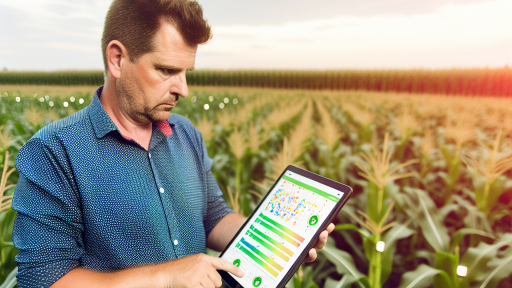Introduction to Precision Agriculture and Its Importance
Precision agriculture represents a revolutionary approach to farming.
This method utilizes technology to enhance crop yields.
It optimizes the use of resources, reducing waste and costs.
Farmers can monitor and manage their fields more effectively.
Additionally, precision agriculture promotes sustainability in farming practices.
Technologies like GPS, sensors, and drones play a vital role.
These tools provide real-time data for better decision-making.
Consequently, farmers can apply fertilizers and pesticides efficiently.
This results in healthier crops and improved soil quality.
Moreover, precision agriculture helps in conserving water resources.
Farmers can target irrigation precisely where and when it is needed.
This practice enhances overall farm productivity and profitability.
Furthermore, it allows farmers to respond quickly to market demands.
They can adjust their practices based on data analytics and forecasts.
Precision agriculture is essential for modern farming.
Transform Your Agribusiness
Unlock your farm's potential with expert advice tailored to your needs. Get actionable steps that drive real results.
Get StartedIt combines technology with traditional agriculture to boost efficiency.
This innovative approach paves the way for a sustainable agricultural future.
Overview of Technologies Used in Precision Agriculture
GPS Technology
GPS technology plays a crucial role in precision agriculture.
Farmers use it to map fields accurately.
This technology enables precise positioning for planting and harvesting.
Additionally, it helps in field variability analysis.
Remote Sensing
Remote sensing allows farmers to monitor crop health.
Drones and satellites provide invaluable data on growth patterns.
This data aids in timely intervention and resource allocation.
Farmers can detect issues such as pest infestations early.
Soil Sensors
Soil sensors measure vital soil properties in real-time.
These sensors monitor moisture levels and nutrient content.
Consequently, they guide irrigation and fertilization practices.
Farmers can optimize resource use while boosting yield.
Data Analytics
Data analytics empowers farmers to make informed decisions.
Farmers analyze collected data for trends and patterns.
This analysis enhances planning for future planting seasons.
It helps identify the optimal planting and harvesting times.
Automation and Robotics
Automation and robotics streamline farm operations significantly.
Robotic systems assist in planting, weeding, and harvesting.
This technology reduces labor costs and increases efficiency.
Farmers can focus more on strategic decision-making.
Data Collection Methods
Sensors
Sensors play a vital role in precision agriculture.
They collect real-time data from the field.
Showcase Your Farming Business
Publish your professional farming services profile on our blog for a one-time fee of $200 and reach a dedicated audience of farmers and agribusiness owners.
Publish Your ProfileSoil sensors measure moisture levels accurately.
Temperature sensors monitor environmental conditions.
Farmers use these insights to make informed decisions.
Ultimately, sensors enhance productivity and efficiency.
Drones
Drones offer a unique perspective on crop health.
Their aerial views help identify problem areas quickly.
Farmers can assess plant health and soil conditions.
Drones also assist in crop mapping and surveys.
This technology saves time and reduces labor costs.
Furthermore, drones can aid in targeted pesticide application.
Satellite Imagery
Satellite imagery provides a broader view of farmland.
This method captures extensive data over large areas.
Farmers analyze vegetation indices from satellite images.
The data reveals insights about plant health and growth.
Additionally, it assists in monitoring weather patterns.
These insights help with strategic planning for crops.
Gain More Insights: The Role of Robotics in Revolutionizing Modern Farming Practices
How Precision Agriculture Improves Soil Management and Health
Understanding Soil Variability
Soyl variability exists on every farm, impacting crop yields.
Precision agriculture techniques assess these variations accurately.
Farmers can identify nutrient deficiencies and excesses across fields.
This data allows targeted interventions for soil health improvements.
Implementing Precision Soil Sampling
Precision soil sampling enhances nutrient management strategies.
This method involves analyzing soil at specific points across the farm.
As a result, farmers obtain detailed insights into soil composition.
Such precision enables them to apply fertilizers more efficiently.
Utilizing Soil Health Indicators
Soil health indicators measure organic matter and microbial activity.
Regular monitoring of these indicators informs management decisions.
For instance, improved soil structure can enhance water retention.
Consequently, crops can thrive even during dry spells.
Integrating Cover Crops
Cover crops are essential for maintaining soil health.
They prevent erosion, suppress weeds, and enhance organic matter.
Farmers using precision agriculture can choose the best cover crops.
This strategy improves soil fertility and nutrient cycling.
Employing Advanced Technology
Technological advancements significantly impact soil management.
Tools like GPS and remote sensing provide valuable data quickly.
These technologies enable precise mapping of soil types.
Farmers can use this data to tailor their management practices.
Enhancing Soil Moisture Management
Soil moisture management is crucial for sustainable agriculture.
Precision agriculture tools measure moisture levels in real-time.
This data helps farmers schedule irrigation more effectively.
Showcase Your Farming Business
Publish your professional farming services profile on our blog for a one-time fee of $200 and reach a dedicated audience of farmers and agribusiness owners.
Publish Your ProfileEfficient water use leads to healthier crops and reduced waste.
Improving Fertilizer Application
Precision agriculture allows for variable rate fertilizer applications.
This practice reduces the overuse of fertilizers in certain areas.
Farmers can apply the correct amount of nutrients where needed most.
Thus, soil health improves while production costs decrease.
Monitoring Soil Compaction
Soil compaction negatively affects crop growth and yields.
Precision agriculture methods help detect compaction issues.
Farmers can then take corrective actions to alleviate compaction.
Increased soil aeration leads to better root development.
Fostering Sustainable Practices
Precision agriculture promotes sustainable soil management practices.
These practices help maintain soil health for future generations.
Farmers become stewards of their land through informed decisions.
Ultimately, this boosts agricultural productivity sustainably.
See Related Content: How AI Is Helping Farmers Predict Crop Failures Before They Happen
The Role of Data Analytics in Enhancing Decision-Making
Improving Data Collection Methods
Data collection methods have transformed in recent years.
Modern technologies allow farmers to gather detailed information.
Sensors and drones collect real-time data efficiently.
This information includes soil moisture, temperature, and crop health.
By utilizing these tools, farmers make more informed decisions.
Analyzing Data for Strategic Insights
Data analytics plays a crucial role in agriculture today.
It helps farmers understand trends and patterns in their fields.
Advanced algorithms can predict yields and pest invasions.
Through statistical analysis, farmers can optimize resource allocation.
This process enhances overall productivity and efficiency.
Enhancing Precision in Farming Practices
Precision agriculture relies heavily on accurate data interpretation.
This approach allows for site-specific management of crops.
Farmers can tailor treatments based on individual field conditions.
This method reduces waste and maximizes output.
Ultimately, it leads to more sustainable farming practices.
Facilitating Real-Time Decision Making
Data analytics enables timely decisions during farming operations.
With immediate access to information, farmers can react promptly.
This immediate feedback loop allows for adaptive management strategies.
Consequently, farmers can mitigate risks and address issues quickly.
This agility is crucial in the face of changing environmental conditions.
Evaluating Performance and Outcomes
Continuous evaluation of farming practices is essential for growth.
Farmers can track the success of different strategies over time.
Data analytics helps benchmark performance against industry standards.
With these insights, farmers refine their methods and improve yields.
This iterative process fosters innovation and sustainability in agriculture.
Gain More Insights: How Drone Technology Is Monitoring the Future of Crop Yields
Showcase Your Farming Business
Publish your professional farming services profile on our blog for a one-time fee of $200 and reach a dedicated audience of farmers and agribusiness owners.
Publish Your Profile
Case Studies: Successful Implementation of Precision Agriculture
Improving Crop Yields in Kansas
A family-run farm in Kansas adopted precision agriculture techniques.
They implemented soil sensors and satellite imagery for better analysis.
This approach allowed them to monitor soil health regularly.
Moreover, they optimized their irrigation practices based on data.
As a result, their corn yields increased by 25% within the first year.
Enhancing Sustainability in California
A vineyard in California turned to precision agriculture for sustainability.
They used drones to assess vineyard conditions and identify issues.
This enabled them to apply water and nutrients more efficiently.
Consequently, their water usage decreased by 30% while maintaining quality.
Additionally, pest control became targeted, reducing chemical use significantly.
Increasing Profitability in Brazil
A large soybean farm in Brazil embraced precision technology for profitability.
They invested in GPS-guided tractors and field mapping tools.
This technology improved planting accuracy and reduced seed waste.
Furthermore, they utilized variable rate technology to optimize inputs.
Ultimately, their operating costs decreased and profits soared.
Boosting Efficiency in Australia
An Australian cattle ranch integrated precision farming methods into their operations.
They utilized wearable devices on livestock to monitor health indicators.
This proactive approach allowed for early detection of illnesses.
Additionally, pasture management became more efficient through data analysis.
As a result, the ranch reported a 15% increase in meat production.
Learn More: Revolutionary Tech Transforming the Future of Farming
Challenges and Limitations of Adopting Precision Agriculture
Initial Costs and Investment
The adoption of precision agriculture often requires significant upfront investment.
This investment includes purchasing advanced technology and equipment.
Farmers may hesitate to adopt these technologies due to high costs.
Financing options can be limited, affecting the decision to invest.
Furthermore, there is uncertainty about the return on investment.
Technical Knowledge and Training
Farmers may struggle with the technical aspects of new technologies.
This transition often necessitates additional training and education.
Many farmers are unfamiliar with data analysis and interpretation.
Consequently, they may miss out on potential benefits.
Access to resources for learning can also be inconsistent.
Data Management and Privacy Concerns
Precision agriculture generates vast amounts of data.
Managing this data can present significant challenges.
Farmers must ensure accurate data collection and interpretation.
Additionally, data privacy is a growing concern for many producers.
They worry about who has access to their sensitive information.
Environmental and Regulatory Issues
Precision agriculture can impact the environment in various ways.
Overreliance on technological solutions may lead to neglecting sustainable practices.
Farmers face regulatory challenges in implementing precision techniques.
Compliance with local and state regulations can be complex.
Showcase Your Farming Business
Publish your professional farming services profile on our blog for a one-time fee of $200 and reach a dedicated audience of farmers and agribusiness owners.
Publish Your ProfileThese complexities can deter farmers from adopting precision agriculture.
Infrastructure Limitations
Many rural areas lack the necessary infrastructure for precision agriculture.
Inadequate internet connectivity can hinder technology use.
Without reliable internet, data collection and communication suffer.
Furthermore, access to technical support may be limited in these regions.
The lack of infrastructure can slow the adoption process significantly.
Future Trends in Precision Agriculture and Their Impact on Farm Efficiency
Advancements in Technology
Technology continues to advance in precision agriculture.
Innovations like drones and satellite imaging enhance monitoring capabilities.
Farmers can gather data on crop health and soil conditions quickly.
These insights lead to informed decision-making on resource allocation.
Data Integration and Analysis
Integrated platforms are becoming essential for farmers.
They enable the collection and analysis of vast data sets.
Farmers can track productivity and optimize operations effectively.
As a result, they improve overall farm efficiency significantly.
Sustainability Practices
Emphasis on sustainability is growing in agriculture.
Precision agriculture encourages responsible resource use.
Techniques like targeted fertilization reduce chemical waste.
This approach not only saves costs but also benefits the environment.
Automation and Robotics
Automation is transforming traditional farming methods.
Robots assist with planting and harvesting tasks.
Additionally, they help minimize labor costs significantly.
Consequently, farms can operate more efficiently and profitably.
Future Market Trends
Market demand for precision agriculture tools is increasing.
Farmers seek solutions that enhance productivity and sustainability.
Investments in technology will likely grow as a result.
This trend indicates a shift towards more efficient farming practices.
Additional Resources
Precision Agriculture: Benefits and Challenges for Technology …




